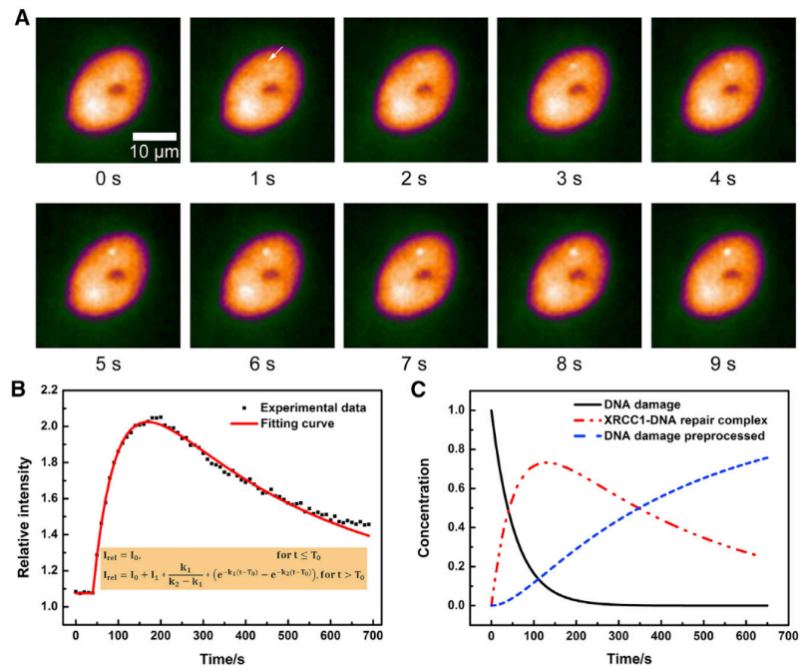Study Reveals High Turnover and Rescue Effect of a Scaffold Protein in Response to Heavy-ion Radiation
Researchers at the Microbeam Technology and Applications Group at the Institute of Modern Physics (IMP) of the Chinese Academy of Sciences (CAS) have discovered the high turnover and rescue effect of an important scaffold protein in response to heavy charged particle radiation. The results were published in Biophysical Journal.
DNA damage response and repair play a decisive role in cell proliferation, carcinogenesis and cancer treatment. After DNA is damaged, a large number of DNA damage sensing and repair factors gather to the damage site in a coordinated and orderly manner to repair the damage.
Scaffold proteins play a central role in coordinating the recruitment and dissociation of DNA damage response factors. They perform the function of stabilizing the damaged DNA and its surroundings, and providing binding sites for response factors, thus facilitating a complete repair process. X-ray repair cross-complementary protein 1 (XRCC1) is an important scaffold protein in the base excision repair and single-strand rupture repair pathways.
Using an on-line live-cell imaging system of the High-energy Microbeam Facility at he Heavy Ion Research Facility in Lanzhou (HIRFL), the researchers studied the response of XRCC1 at the localized DNA damage in charged particle irradiated HT1080 cells.
The results demonstrated that the response of XRCC1 is extremely fast at the localized DNA damage of heavy ion hits, and the molecular dynamics behavior of XRCC1 is consistent with the consecutive reaction model.
The researchers then exposed the same cells to fractionated irradiation with a large number of ion hits. By quantitatively analyzing the recruitment and dissociation rate constants of XRCC1 molecules, it was found that fractionated irradiation of the same cells results in accelerated dissociation of XRCC1 at the old damage site, while dissociated XRCC1 is immediately recycled with a higher efficiency.
This work reveals the new rescue mechanism of XRCC1 and its high turnover mechanism in DNA damage response, which sheds new light on the DNA damage response mechanism and biological effects induced by heavy-ion irradiation from the perspective of biochemical reactions.
This work is supported by the National Natural Science Foundation of China and the Key Research and Development Program of the Ministry of Science and Technology.

Figure 1. On-line fast imaging of HT1080 cells and the early kinetics of XRCC1 molecules after irradiation using 2.15 GeV krypton ions. (Image by LIU Wenjing)

Figure 2. Accelerated dissociation of XRCC1 molecules from old DNA damage repair site (the first ion hits, black curve) after second irradiation (the second ion hits, red curve). (Image by LIU Wenjing)
Contact Information
Institute of Modern Physics
Email: fangliu@impcas.ac.cn


 甘公网安备 62010202000713号
甘公网安备 62010202000713号


